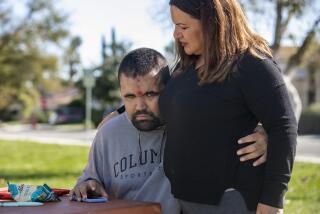Champions of the Ill and Elderly
A year ago, when Nancy Cunningham got her first assignment as an ombudsman for elderly patients at a Pasadena convalescent home, she was appalled. The facility was so bleak and depressing that she wasn’t sure if she could visit the home once a week to listen to and help resolve patient complaints.
“The odor of urine just knocked me over,” said Cunningham, a retired Caltech personnel administrator who is one of an estimated three dozen volunteer ombudsmen in the San Gabriel Valley who regularly visit long-term care facilities under a federally mandated program.
A year later, Cunningham is still visiting the same facility, which she would not identify in the interests of maintaining the good working relationship she has established with both patients and administrators there.
She drops in, unannounced, about once a week, and chats both with patients and administrators about their problems.
But now, rather than dreading the visits, Cunningham looks forward to them.
“When you see a real turnabout in patient care, in the attitude of nursing aides and the people who are taking care of the patients, then it makes it worthwhile,” Cunningham said.
“When I got there last Tuesday at 10 a.m., there were about 20 patients out in the sun on the patio, doing arm exercises in their wheelchairs.
“I never saw them doing that before.
“Most of the odors are gone and the air is fresh,” she said.
Cunningham says she can’t take credit for the dramatic changes that have taken place at the convalescent home she visits. She attributes most of the improvements there to personnel changes, including the hiring of a new administrator who, she says, “really wants to know when there are problems.”
But, she says, the repeated visits at irregular intervals keep administrators on their toes, and many of the problems she encountered at first, such as unpleasant odors and inattention to some aspects of cleanliness, have gradually disappeared.
“When I first went there, it was really depressing. But now every room is tidy, the floors are shining. They’re fixing up the dining room and working on the landscaping.”
The primary job of an ombudsman is to listen to patient complaints, determine if they are valid and attempt to solve them. A discussion with the administrator often resolves the problem, but sometimes authorities ranging from health officials to police agencies are called in.
A part of a federal and state program set up under the Older Americans Act, the ombudsman program did not get started in the San Gabriel Valley until last year. The act as amended in 1978 requires states to establish a coordinated system of state and local advocacy services to respond to the complaints and problems of older people living in long-term care facilities.
Every complaint is investigated, said Maria Arechaederra, executive director of the Westside Independent Services to the Elderly, a Santa Monica agency that was selected by the state in 1983 to administer the ombudsman program in much of Los Angeles County, including the San Gabriel Valley.
“If a person’s safety is involved, we investigate immediately,” she said. Other complaints are handled as soon as possible.
Under the program, long-term-care facilities are required to set up accessible telephone hot lines on which patients can call a toll-free number to report complaints and problems.
“We get 7 to 10 calls on the hot line each day, but in addition to investigating complaints, we like to have volunteers visit on a regular basis because this is preventive in nature.”
The Westside agency gets funds from federal, state and private sources to administer the ombudsman program and last year established regional offices, including five in the San Gabriel Valley staffed by three paid coordinators.
The coordinators each work with 12 to 15 volunteers to cover the estimated 200 long-term-care facilities in the San Gabriel Valley. In the East San Gabriel and Pomona valleys, which have the highest concentration of such facilities, the coordinator is assisted by a part-time paid case investigator.
Arechaederra said the program depends on assertive, self-motivated volunteers who are able to evaluate issues objectively and provide concrete solutions to problems.
Volunteers are required to complete an initial 30-hour course and continuing training on the concepts of aging, nursing home law, patients’ rights and the complaint process.
Although some administrators object to the program, others say they have found benefit in the work of the ombudsmen.
Sherman Davidson, administrator of the Monrovia Convalescent Hospital in Duarte, said his experience with the program has been positive.
“Often the patient has a problem, such as not getting his milk on time, but he doesn’t tell us. So we get feedback through the ombudsman. The ombudsman gets the patients to open up to them when they won’t open up to us.
“Most problems are little problems, but when you are sick and have nothing to look forward to they become big problems.
“I did have a staff problem at one time and while I would have heard about it eventually, I heard sooner through the ombudsman and was able to nip the problem in the bud.”
Marcella Brown, who is administrator of Eisenhower Nursing and Convalescent Hospital, Villa Oaks Convalescent Hospital and Sophia Lyn Convalescent Hospital, all in Pasadena, said many administrators are fearful of the program because they think it means trouble.
“They (the ombudsmen) don’t alarm me because I have always been on top of every problem they have mentioned,” she said.
“I did have one ombudsman who came on too strong. She told the patients she was there to be sure they are treated right and I felt in effect she was suggesting to them that they were not being treated properly.
“But I have learned to accept the program and live with it. And it could help us. We can’t find out who is handling the finances of one of my patients and if the ombudsman finds out it will help us because the patient owes us money,” Brown said.
“We have clout,” Cunningham said, pointing out that under law, ombudsmen must be allowed on the premises at any time, day or night, must be permitted to speak with patients privately and have access to certain records. Any attempt to interfere with them can result in a civil penalty.
Ombudsmen sign up for a year and work a minimum of four hours a week. Most are assigned to make unannounced visits to a specific facility every week, looking for signs of neglect and county Health Department violations. Some ombudsmen “float,” checking out calls made by patients on the hot lines.
Cunningham, who began her volunteer ombudsman work as part of a master’s degree program in human development with an emphasis on gerontology, said the work was especially difficult at first.
“Patients would tell me, ‘Everything is fine,’ because they were afraid if they reported anything there would be retaliation,” Cunningham said. “And there was.”
She cited as examples cases in which patients who complained said they later missed meals or received cold food.
Both patients and administrators were leery of her.
“You’re sort of in the middle. But you do get to know the people, and after a while they know you won’t violate their confidence,” she said.
Now that the patients know and have grown to trust her, they speak openly to her about their problems.
Most of the San Gabriel Valley ombudsmen are retired men and women whose backgrounds make them particularly suited for the difficult volunteer work. Two are retired attorneys, two are retired nurses, one formerly owned a board and care facility, one had been a patient at such a facility and another is a former social worker.
“It’s a rewarding type of volunteer duty,” said Arthur Weinberger, a retired attorney and pharmacist who regularly visits two San Gabriel Valley homes. “I’ve always wanted to be useful and now I have the time.”
Ombudsmen say that problems reported by patients run the gamut from inedible food and improper care to thefts and sexual assaults.
Cunningham was quick to point out that not all patient complaints are valid.
“One man said he couldn’t get aspirin for his arthritis but it turned out he hadn’t requested it. And some are mental patients, so we can’t make quick judgments.”
The home Cunningham visits has built-in problems because of its size and the type of patients it cares for.
“This particular home is very large, with 99 beds, and most of the patients are on Medi-Cal with no families to visit them,” she said.
“One woman’s bank account had been ripped off. Someone had applied for an automated teller card in her name. We never knew if it was an inside job, but the bank reinstated most of the money.”
Cunningham said the complaints she first handled often involved subtle forms of abuse.
“I saw a man in a wheelchair out in the hall. He asked a male aide to wheel him back to his room, then apparently changed his mind. The aide grabbed the chair and yanked it backward, hitting the man against the wall.
“And I discovered that when too many patients complained about abusive aides, the aides were not fired but traded off to another home in the area (in which there is a high concentration of nursing homes) where they weren’t known by the patients.
“One of my first little victories was making sure the hot line poster was properly displayed. It took a month, but I finally got it put up by the pay phone.
“This still is not a model convalescent home, but even the Cadillac facilities have problems,” she said, citing as an example one very expensive home in the area that is being sued because of alleged sexual assaults on two patients by a young male aide.
“We found out about that through the hot line,” she said.
Weinberger said sometimes the problem lies with both the patient and the people who administer the home.
“In one facility there was an 84-year-old lady who was a chronic complainer. But she seemed to be failing so I checked her medical chart. She had lost 10 pounds in six months and only weighed 72 pounds. The administrator said she was refusing to eat and this was true.”
Weinberger solved that problem by persuading the cook to widen his menus to include food that the patient enjoyed.
He said that most of the complaints he gets involve the preparation and quality of food.
“I can sympathize because in any institution the food is not going to be satisfactory to everyone,” he said. “I can’t do much about the food but I do observe preparation in the kitchen.”
Weinberger said helping patients takes time, effort and objectivity.
“The way to determine if a complaint is valid is to follow through to substantiate it. You have to find the evidence. It takes dedication and determination to follow through, especially with resentful administrators.”
Lucie James, ombudsman coordinator for Pasadena and much of the West San Gabriel Valley, said most of the complaints that come to her attention involve the quality of care. Food, theft and cleanliness are also common problems.
“We try to resolve the problems and make the patient aware of options. One woman had $400 worth of clothing stolen. We talked to the administrator, who was not cooperative. We are now trying to contact other family members but we have explained to her that we will help her go to civil court or even contact the police.”
James said the ombudsmen generally explain to patients what options are available and work with administrators and families to solve problems. If legal action is involved, coordinators step in, handling calls to attorneys and police.
“One woman said $8,000 had disappeared and we discovered five different employees were taking money over a period of time. In this case we will go to the police department.”
Ombudsmen do their best to protect the identity of patients who complain, but in one case, James said, it took a cooperative staff member to solve the problem.
“Patients told us a staff member was physically abusive but they were too scared to name the person. We then got an anonymous phone call from another staff member at that facility giving us enough information to go to the administrator.
“Administrators tend to say that complaining patients are confused and disoriented, but even if the complaint is out of proportion, there is always a problem of some sort.”
More to Read
Sign up for Essential California
The most important California stories and recommendations in your inbox every morning.
You may occasionally receive promotional content from the Los Angeles Times.









